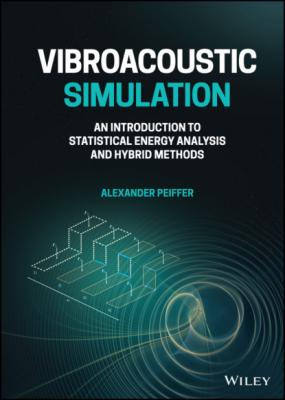Vibroacoustic Simulation. Alexander Peiffer
Чтение книги онлайн.
Читать онлайн книгу Vibroacoustic Simulation - Alexander Peiffer страница 27
 alt="bold-italic upper S Subscript f g Baseline left-parenthesis omega right-parenthesis equals upper E left-bracket bold-italic upper F Superscript asterisk Baseline left-parenthesis omega right-parenthesis bold-italic upper G left-parenthesis omega right-parenthesis right-bracket"/> (1.166)
alt="bold-italic upper S Subscript f g Baseline left-parenthesis omega right-parenthesis equals upper E left-bracket bold-italic upper F Superscript asterisk Baseline left-parenthesis omega right-parenthesis bold-italic upper G left-parenthesis omega right-parenthesis right-bracket"/> (1.166)
Note that the cross correlation Rfg(τ) of time signals f(t) and g(t) can be reconstructed from the inverse Fourier transform.
1.5.5 Estimation of Power and Cross Spectra
As shown in section 1.5.4 and Equation (1.164) the expected value of the Fourier transform of an ensemble of signals of infinite duration is given by:
It is helpful to convert this into an expression for a finite number of signals of finite duration. Usually, there is one signal of time length T available that is separated into M partitions of length Tw. So the estimate would be:
In Bendat and Piersol (1980) it is shown that the relative error is given by:
So for a given time length T the more we average, the more precise is the spectral estimate, but we sacrifice spectral resolution against statistical precision.
Figure 1.23 Sketch of a single-input–single-output system. Source: Alexander Peiffer.
1.6 Systems
Any car, building, air plane or machine represents a dynamic system. This dynamic system is excited by source function f(t), e.g. a force. The excitation is called the input of the system. This excitation leads to a specific response g(t) called the output of the system. The simplest cases are systems with one input and output, e.g. the forced harmonic oscillator. Those systems are called single-input–single-output systems (SISO). Real systems are usually driven by multiple inputs or sources and have continuous or multiple responses. Those are called multiple-input–multiple-output systems (MIMO). Every system is described by its transfer function: i.e. a functional expression H that relates the inputs to the outputs.
The practical advantage of such a formalism is that a complex realistic system is reduced to the quantities of interest. All intermediate steps of sound and vibration prediction are neglected. A practical example would be the force from the engine mount as input exciting the car system. A reasonable output could be the sound pressure at the drivers ear.
We restrict our considerations to linear systems. Thus, the response of the system to the sum of two signals f1(t) and f2(t) is given by the sum of each single response
If the inputs are multiplied by constants a and b the responses scale linearly with the input
This is called the superposition principle.
1.6.1 SISO-System Response in Frequency Domain
The Equation (1.28) for the displacement response of the damped harmonic oscillator
is an example for a system response in frequency domain. With u and Fs as complex amplitudes of harmonic signals we can express the system properties easily in the frequency domain
Thus, H(ω) is the system transfer function in frequency domain. It is usually a complex function.
1.6.2 System Response in Time Domain
The product of Fourier transforms corresponds to a convolution in time domain (1.42), hence:
or alternatively, as